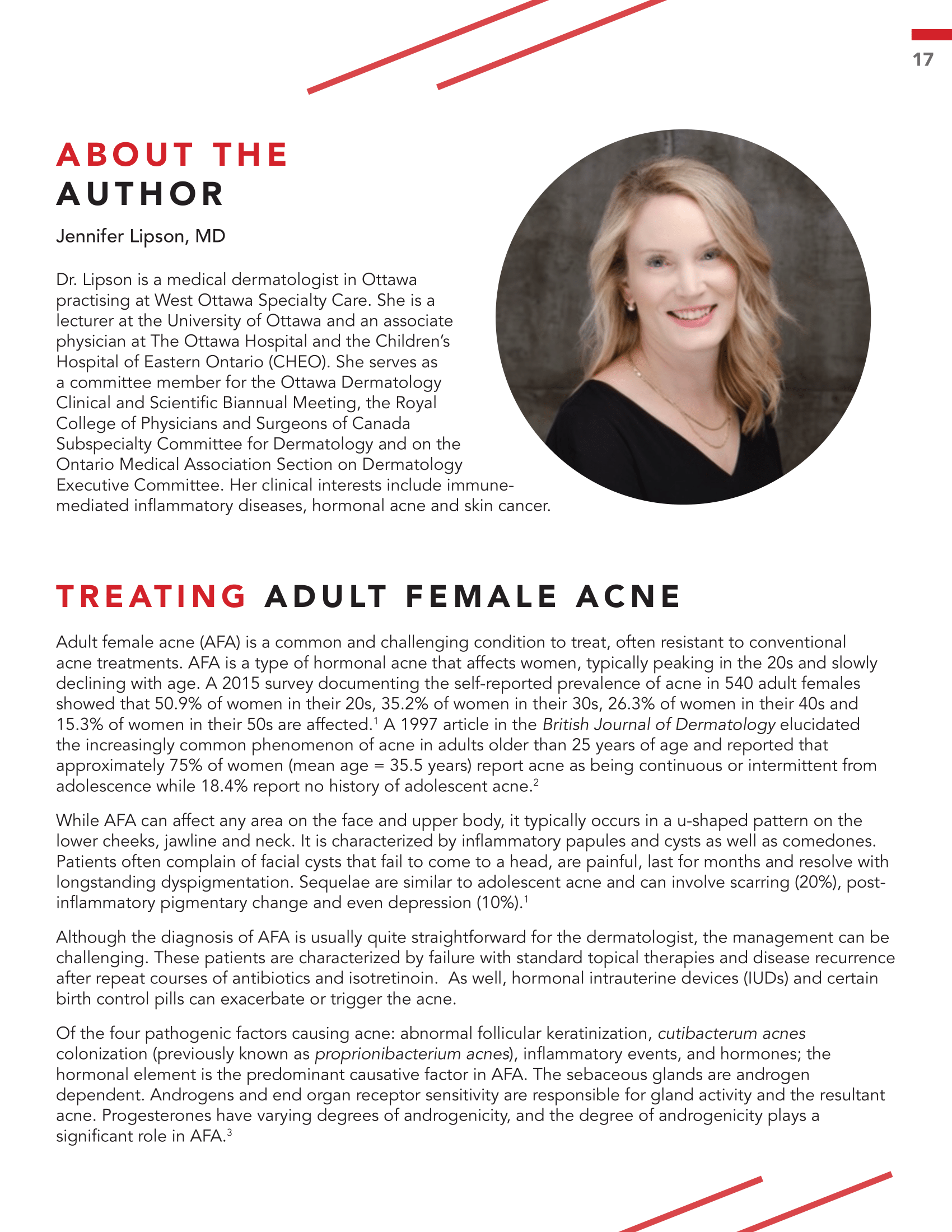Treating Adult Female Acne
Abstract
Adult female acne (AFA) is a common and challenging condition to treat, often resistant to conventional acne treatments. AFA is a type of hormonal acne that affects women, typically peaking in the 20s and slowly declining with age. A 2015 survey documenting the self-reported prevalence of acne in 540 adult females showed that 50.9% of women in their 20s, 35.2% of women in their 30s, 26.3% of women in their 40s and 15.3% of women in their 50s are affected. A 1997 article in the British Journal of Dermatology elucidated the increasingly common phenomenon of acne in adults older than 25 years of age and reported that approximately 75% of women (mean age = 35.5 years) report acne as being continuous or intermittent from adolescence while 18.4% report no history of adolescent acne.
References
Drena B. Treatment of adult female acne: a new challenge. JEADV. 2015;29(supplement 5):14-19.
Bagatin E, et al. Adult female acne: a guide to clinical practice. An Bras Dermatol. 2019;94(1):62-75.
Bosanac S, et al. Progestins and acne vulgaris: a review. Dermatology online journal. 2018;24(5):1-6.
Apgar B, et al. Using progestins in clinical practice. Am Fam Physician. 2000;62(8):1839-1846.
Arowojolu A, et al. Combined oral contraceptive pills for treatment of acne. Cochrane Database of Systematic reviews. July 2012.
Mirena and Kylena Drug monographs.
Lortscher D, et al. Hormonal contraceptives and Acne. A retrospective analysis of 2147 patients. J Drugs Dermatol. 2016;15(6):670-674.
Barbieri JS, et al. Influence of contraception class on incidence and severity of acne vulgaris. Obstet Gynecol. 2020;135(6):1306-1312.
Lullo JJ, et al. Incidence of androgenic dermatologic side effects following placement of a levonorgestrel intrauterine device for menorrhagia: A survey-based study. J Am Acad Dermatol. 2018;79(2):364-365.
Buzney E, et al. Polycystic ovarian syndrome, a review for dermatologists. J Am Acad Dermatol. 2014;71(5):859.
Reid R, et al. Oral Contraceptives and the Risk of Venous Thromboembolism: An Update. SOGC Clinical Practice Guideline. JOGC. 252:1192-1197.
Kimball A, et al. Acne and oral contraceptives. Update on women’s health screening guidelines. J Am Acad Dermatol. 2008;58(5):781-786.
Garg V, et al. Long term use of sprinolactone for acne in women: a case series of 403 patients. J Am Acad Dermatol. 2021;84(5):1348-1353.
Plovanich M, et al. Low usefulness of potassium monitoring among healthy young women on spironolactone for acne. JAMA Derm. 2015;151(9):941-944.
Azarchi S, et al. Androgens in women: Hormone modulating therapies for skin disease. J Am Acad Dermatol. 2018;80(6):1509-1520.
Butler D, et al. Safety of dermatologic medications in pregnancy and lactation. Part II Lactation. J Am Acad Dermatol. 2014;70(3):417.e2-e10.
Herbert A, et al. Efficacy and safety of topical clascoterone cream, 1%, for treatment of patients with facial acne. Two randomized controlled phase 3 studies. JAMA Derm. 2020;156(6):621-630.


